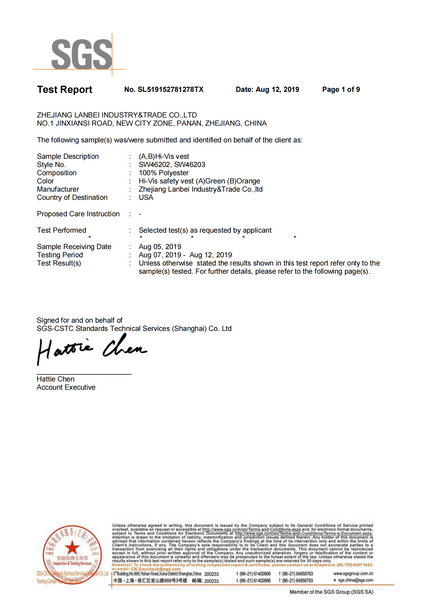ANSI/ISEA 107-2015 is a certification standard issued by the American National Standards Institute (ANSI) and the International Safety Equipment Association (ISEA). The standard outlines the requirements for high-visibility safety apparel (HVSA) in the United States. The certification is specifically related to garments and accessories designed to enhance the visibility of workers in low-light or high-risk environments, thus reducing the risk of accidents and increasing overall safety.
The ANSI/ISEA 107-2015 standard establishes different performance classes for high-visibility safety apparel based on the amount of fluorescent background material and retroreflective material used in the garment. The classes range from Class 1 (lowest visibility) to Class 3 (highest visibility), with Class 2 offering an intermediate level of visibility. Categorised by how much fluorescent and retroreflective material is used in the garments. Each class is meant for different work environments depending on the risk level and traffic conditions.
Class 1: This class is for low-risk work areas with traffic speeds under 25 mph and ample separation between workers and traffic. It's commonly used in places like off-road sites or parking lots. Class 1 garments must have at least 217 square inches of fluorescent background material and 155 square inches of retroreflective material.
Class 2: This class is suitable for moderate-risk work environments where workers are exposed to traffic speeds between 25 and 50 mph. It's commonly used in construction, roadwork, and similar activities near roadways. Class 2 garments must have at least 775 square inches of fluorescent background material and 201 square inches of retroreflective material. Some Class 2 garments also have added features like reflective vests with sleeves for better visibility.
Class 3: This is the highest visibility class intended for high-risk work environments with traffic speeds exceeding 50 mph or during bad weather conditions. It's commonly used by emergency responders, roadway construction workers, and others in high-risk jobs. Class 3 garments must have at least 1,240 square inches of fluorescent background material and 310 square inches of retroreflective material. Class 3 garments usually provide full-body coverage for maximum visibility.
It's essential for employers and workers to choose the right class of HVSA based on their specific work environment and the level of risk. Wearing the appropriate high-visibility safety apparel significantly increases worker visibility, reducing the risk of accidents and improving overall safety, especially in situations where visibility is critical for worker protection.
Key features and requirements of ANSI/ISEA 107-2015 certification include:
-
Fluorescent Background: The garment should have a specific amount of fluorescent background material that enhances visibility during the daytime.
-
Retroreflective Material: The garment must incorporate retroreflective material that reflects light back to its source (e.g., headlights) to make the wearer more visible in low-light conditions.
-
Color and Design: The standard specifies color combinations for the fluorescent background and retroreflective materials, and it outlines design requirements to ensure the visibility of workers from all angles.
-
Garment Performance Classes: The standard defines three classes (Class 1, Class 2, and Class 3) based on the amount and configuration of the fluorescent and retroreflective materials. The class required depends on the specific work environment and risk level.
-
Labeling and Marking: ANSI/ISEA 107-2015 sets guidelines for garment labeling, including the location and content of labels that indicate the class of the high-visibility apparel.
-
Washability and Durability: The standard also includes requirements for the durability and washability of the high-visibility garments to ensure they maintain their visibility and performance over time.
The ANSI/ISEA 107-2015 certification is essential for manufacturers of high-visibility safety apparel to ensure their products meet the necessary visibility and performance requirements. Additionally, for workers who need to be visible in potentially hazardous environments, wearing ANSI/ISEA 107-2015 certified garments helps improve their safety and reduces the risk of accidents, particularly in industries such as construction, transportation, roadwork, and utility work, where visibility is critical for worker safety.


